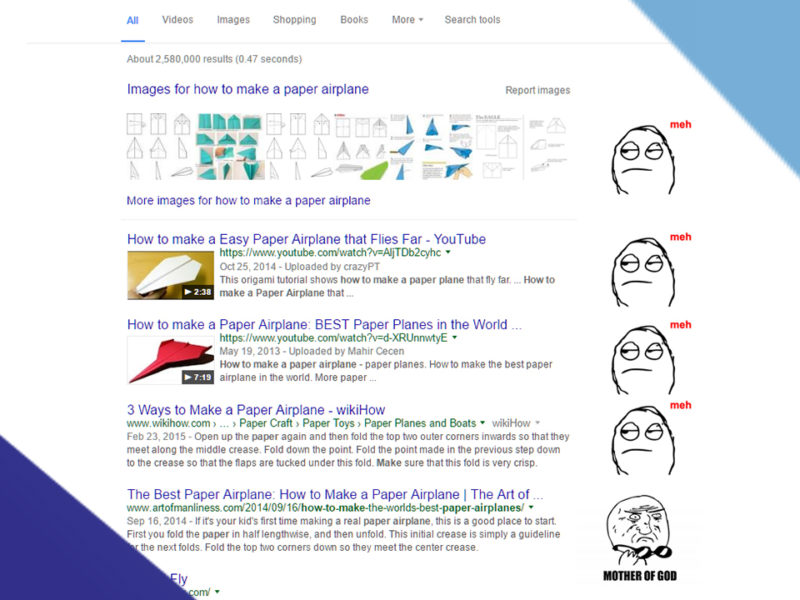Why Ranking On The First Page Of Google Isn’t Always Enough
Ah, ranking on the first page of Google! It’s a coveted position to be in, yet there’s so much confusion surrounding first page rankings. You see, many people,with the biggest offenders being small business owners, are under the impression that once they get on the first page, the floodgates will open and so much traffic will pour into their website, that they won’t know what to do with it all!
However, here’s the problem with paying someone to just rank you on the first page of Google: first page results on Google do not guarantee traffic.
What!? But how can this be? Well, allow me to explain.
Why Getting On The First Page Of Google Doesn’t Guarantee Traffic
Put simply, ranking on the first page of Google simply means that you have first page rankings for that keyword. However, not all keywords are created equally and some results are more likely to be clicked on than others. How do I know this? Because I’ve ranked on the first page for popular keywords in the past and received very little traffic from them (more on that later).
You see, there are a few factors people don’t take into consideration when they hire someone to perform search engine optimisation for them. Factors such as conversion rate optimisation, search volume, and keyword intent are what determine how much traffic you receive for the keyword you ranked for.
Conversion Rate Optimisation
This is an industry that most search engine optimisers are still unfamiliar with, despite the importance it has in running a proper SEO campaign. Conversion rate optimisation (CRO) is generally the act of increasing the number of visitors on a website into customers, thus increasing the website’s conversion rate.
Now, as far as SEO is concerned, CRO plays a big part in getting Google searchers on your website by creating enticing titles and descriptions. In this case, the converting action is the web searcher clicking your link in Google.
So that leads us to the next question: how do you create an enticing title and description? Unfortunately, there’s no one-size-fits-all answer. A basic strategy that most people use involves including words like “best” or “ultimate” in the title, but I’d like to share an excerpt with you from a guide I created for the black hat SEO forum Black Hat World titled, “The Only SEO Guide That’s Worth Your Time“. It’s there that I shared a few general guidelines under part 4 of the guide on how to create a title for your article, which also applies to your description.
For this part of the guide, we’re going to be taking a trip back to the SERPs, but this time we’re going to analyse how the competition is writing their titles. In this part of the guide, we’re going to be searching for the keyword “how to make a paper airplane”.
Look at all of those “meh” results! But wait… The BEST paper airplane!? Well, you had my curiosity, but now you have my attention!
“The Best Paper Airplane: How to make a Paper Airplane”. Look at how captivating that title is. Let me tell you something, I searched for that key term a couple of years ago for a school I was volunteering at in my free time, and that was the first result that caught my attention, and the only one I clicked on. Sure, the other results rank higher and they might seem nice with their lists, videos, and simple instructions; but why would anyone want to create just a paper airplane when they could create the best paper airplane!? Do you see where I’m going with this? A captivating title equals a better CTR. A better CTR means you get more traffic going to your website when you rank for that one keyword. But how do you create a captivating page title? Well, there’s no specific formula, but here are some general guidelines.
- Avoid using a title that’s already being used in the SERPs.
- Use lists if you can. The bigger the better; unless it’s too big, I’ve had that backfire on me once.
- Use exaggerated words like best, ultimate, greatest, et cetera.
- Allude to solving a problem that a user never knew that wanted to be solved. Example: How to tie a tie that will never come undone.
Keyword Search Volume
Some people get excited when they rank on the first page of Google for any keyword, so they’ll target keywords like, “ultimate sexy fishing gear and stripping pole provider and marketer”. Do you want to know what kind of keyword that is? It’s a garbage query. There’s not a single soul on this planet that is searching for that in Google. That is, unless you decide to search for it right now. I know I just did (don’t do it; NSFW).

So you see the problem with this, right? If nobody is searching for the keyword you’re ranking on the first page of Google for, you’re not going to get traffic in position #1 or position #10.
On a side note, a common scam you see in the SEO industry involves shoddy search engine optimisers ranking their clients for keywords like this. The clients are often delusional and attribute their rankings for these garbage queries with an actual increase in business, unaware of the fact that nobody searches for these keywords. It’s sort of like a placebo effect for online marketing.
Keyword Intent
There are 4 types of keyword: commercial, informational, navigational, and transactional. Other people will try to tell you there are more than 4 types of keywords, but these people are just over-complicating the topic. I won’t go over these types of keyword in-depth, but I’ve provided short descriptions of each one below.
- Commercial: These are keywords where the searcher shows an interest in finding a product or service (e.g., SEO services in Los Angeles).
- Informational: These are simply keywords that contain questions (e.g., how to tie your shoes).
- Navigational: These are keywords where the searcher is looking for a specific product, brand, or service (e.g., Sycosure).
- Transactional: These are keywords where the searcher is further along in the buying process. They already know what they want, so they’ll type in “buy” or “for sale” before or after the main query.
For instance, ranking your shoe store on the first page of Google for the informational keyword “how to tie your shoes” is asinine. If someone is asking how to tie their shoes, they probably already have shoes that they want to know how to tie. Instead, you would want to rank your shoe store for a commercial or transactional keyword. While it’s certainly possible for some gifted marketers to pull this off, it’s unlikely to happen.
Now, do you remember at the beginning of this article how I mentioned that I ranked on the first page of Google for a popular keyword that brought in very little traffic to my website? Well you see, back in 2014, I targeted the brand name of a fairly popular SEO tool company (I forgot which one, I think it was a keyword tool for SEO Book or one of those websites) for an article comparing the tool to another tool. I ranked in positions 4-10 for about 2 months before being pushed back to the 3rd page, then the 4th page, then onward to the unknown.
The brand name received several thousand searches per month, yet I only saw about 20 of those visitors. If you’ve been paying attention to this article, then you already know what the issue here was: I was ranking for navigational keyword for my informational article. The people searching for the brand were most likely looking for the keyword tool that this business offered. They were already familiar with the brand, so when they saw my article comparing the keyword tool they know and love with a keyword tool they don’t know about, they just went about their daily business and clicked the main brand website.
Conclusion
All of the problems above can be summarised by one issue: not seeing the bigger picture. Reason #6 in Trond Lyngbø article on Search Engine Land titled, “6 reasons why SEO fails, and how you can succeed at it“, actually over this in the SEO industry.
Failing to see the big picture
Above all else, a good SEO consultant’s role is to understand clients’ needs and educate them on how SEO can help them achieve their goals. Sometimes it is important to remind ourselves that meeting business objective is what really matters — not obtaining high rankings or creating perfectly optimized pages.
SEO strategy is about constantly moving the needle. Generating more money for the client’s business. Acquiring more customers. Making more sales. Retaining current rankings and traffic. And keeping clients happy by delivering results.
So next time you decide to rank f
- Slow Website? Consider Robots As Being The Culprit - June 24, 2025
- My Experience Accepting Crypto Payments For The First Time - April 25, 2025
- Are Forums Dying? A Look Into Forums As A Whole - April 22, 2025


Leave a Reply